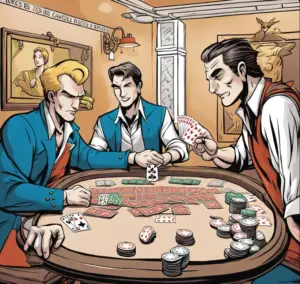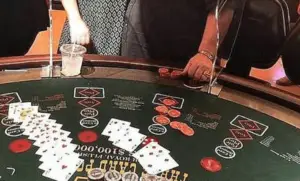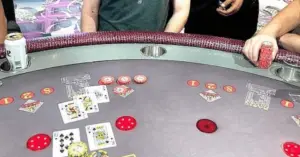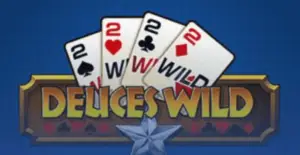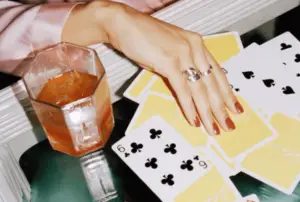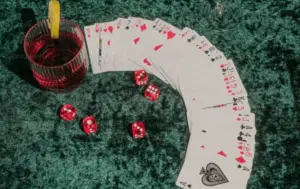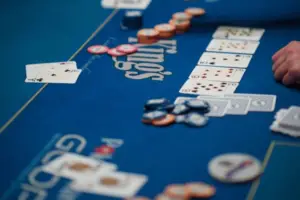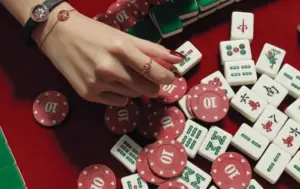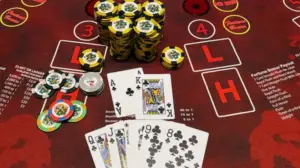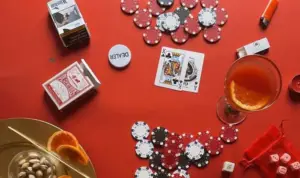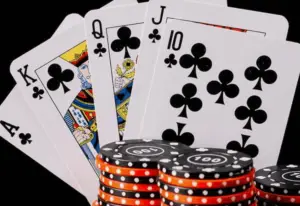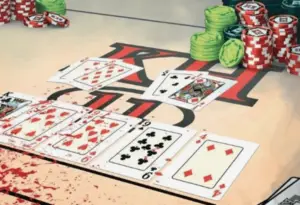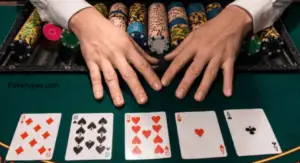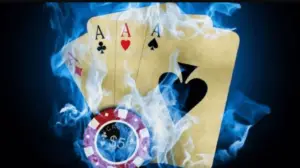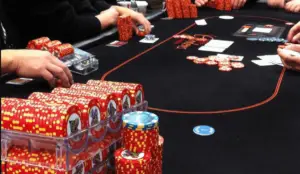Poker betting is the heart and soul of the game. It’s how you win big or lose your shirt. In poker, you’re not just playing your cards – you’re playing the people across the table.
Betting lets you bluff, build the pot, and put pressure on your opponents. There are four main betting moves: check, bet, call, and raise.
When you check, you’re saying “I’ll pass for now.” Betting means you’re putting chips in the middle. Calling is matching someone else’s bet. And when you raise, you’re upping the ante. Each move tells a story about your hand.
For example, if you’ve got pocket aces (a 220-to-1 shot), you might want to raise to build the pot. But if you’re on a flush draw, you’ll need to weigh the pot odds before calling.
Mastering these moves is key to becoming a poker shark. So, next time you sit down at a poker table, remember: your bets speak louder than words.
Fundamental Betting Actions

In poker, there are five key moves you need to know: check, bet, call, raise, and fold. These are your bread and butter at the poker table.
1. Check
When you check, you’re saying “I’m good for now” and passing the action to the next player. It’s like taking a rain check on betting. You can only check if no one else has put chips in the pot yet.
2. Bet
Betting is when you’re the first to put money in the middle. It’s a way to build the pot, show strength, or bluff your opponents. You’re saying “I’ve got a hand, who wants to play?”
3. Call
Calling means matching someone else’s bet. If a player before you bets $10 and you call, you’re putting in $10 to stay in the hand. You’re basically saying “I’ll see your bet and raise you… nothing.”
4. Raise
When you raise, you’re not just calling the bet, you’re bumping it up. If someone bets $10 and you raise it to $20, now they have to put in an extra $10 to stay in. Raising is a power move that puts pressure on your opponents.
5. Fold
Sometimes the best move is to fold. When you fold, you’re throwing in the towel and giving up on the hand. It might feel like quitting, but it’s really just smart poker. No shame in folding when the odds aren’t in your favor.
These five actions are the backbone of poker. Checking and calling are the bread, betting, and raising are the butter, and folding is knowing when to say “No thanks, I’m on a diet.”
Mix ’em up, keep your opponents guessing, and you’ll rake in the chips in no time. Just remember, poker is a long game.
You win some, you lose some, but as long as you’re making smart moves, you’ll come out on top in the end.
And if all else fails, just remember what Kenny Rogers said: “You’ve got to know when to hold ’em, know when to fold ’em.” Words to live by, my friend.
Betting Structures in Poker
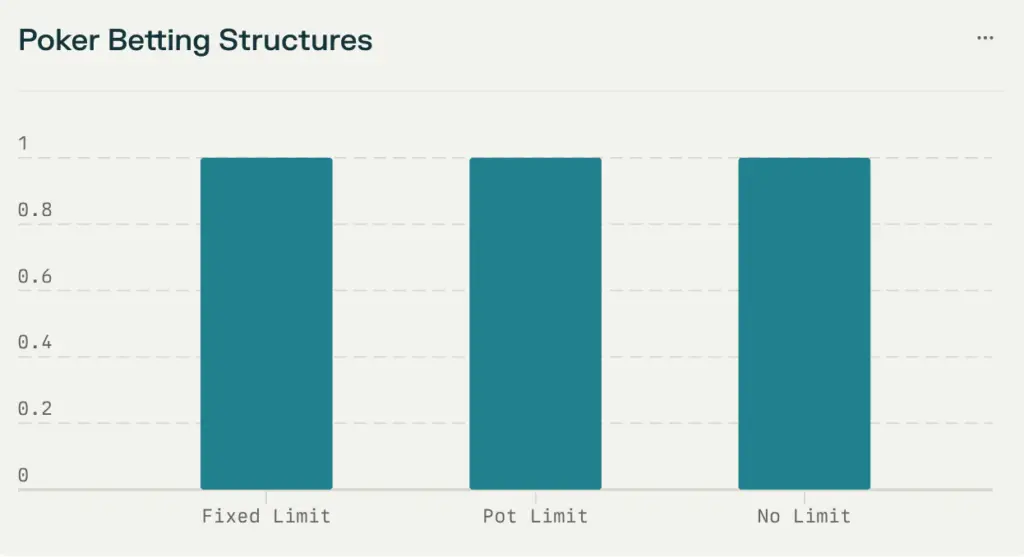
Let’s explore poker betting structures. There are four main types, and each one changes the game in its own way.
1. No-Limit
No-Limit is the wild child of poker. It’s like playing with dynamite – exciting but dangerous. In No-Limit Texas Hold’em, you can bet all your chips at any time.
That’s why they call it the “Cadillac of Poker.” The only rule? Your bet must be at least as big as the big blind. So in a $1/$2 game, you gotta bet at least $2. But after that, the sky’s the limit!
2. Pot-Limit
Pot-Limit is the middle child. It’s not as crazy as No-Limit, but it’s got more kick than Fixed-Limit. In Pot-Limit Omaha, the biggest bet you can make is the size of the pot.
Sounds simple, right? Well, it can get tricky. Here’s a pro tip: take the pot size, multiply it by 3, and add what’s already in there. That’s your max bet. It’s like solving a mini math puzzle every hand!
3. Fixed-Limit
Fixed-Limit is the strict parent of poker betting. Everything’s set in stone. In a $2/$4 Fixed-Limit Hold’em game, you can only bet or raise in $2 chunks for the first two rounds, then $4 for the last two.
It’s like poker with training wheels – less risky, but also less thrilling. Oh, and there’s usually a cap on raises – often three per round.
4. Spread-Limit
Spread-Limit is the quirky cousin. It’s not as common, but it’s got its fans. In a $1-$5 Spread-Limit game, you can bet anywhere from $1 to $5 each time. It’s like a buffet of betting options!
Each structure has its own flavor. No-Limit is a rollercoaster, Pot-Limit is a puzzle, Fixed-Limit is a steady climb, and Spread-Limit is a mixed bag. Pick your poison and may the poker gods be with you!
What are Forced Bets in Poker?
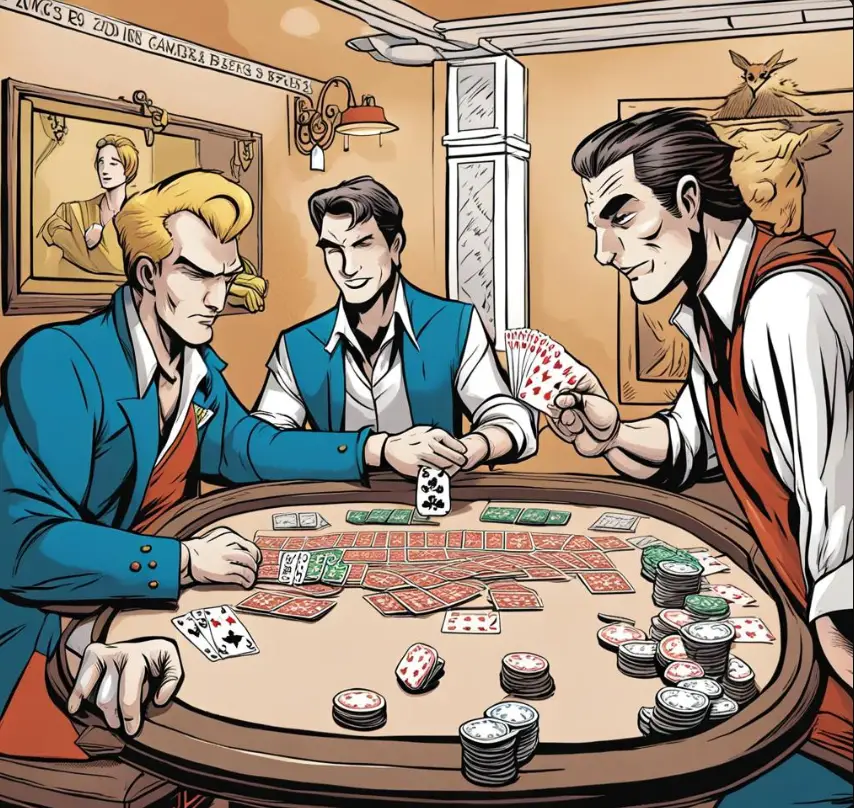
In poker, forced bets are like the cover charge to get into the club. You gotta pay to play, baby! There are three main types of forced bets: blinds, antes, and the bring-in.
1. Blinds (small and big)
Blinds are the most common forced bets in games like Texas Hold’em and Omaha. The player to the left of the dealer puts in the small blind, and the next player puts in the big blind, which is usually double the small blind.
In a $1/$2 game, the small blind is $1 and the big blind is $2. These bets get the pot started before any cards are even dealt!
2. Antes
Antes are like blinds, but everyone at the table has to pony up. In some games, each player posts a small ante before the hand starts.
It’s like a little appetizer before the main course. In a $2/$5 game with a $1 ante, everyone tosses in a buck before the cards fly.
3. Bring-in (in stud games)
The bring-in is the wild card of forced bets. It’s used in stud games like Seven-Card Stud. The player with the lowest face-up card has to post the bring-in, which is usually smaller than the small bet.
In a $10/$20 stud game, the bring-in might be $5. The player can also “complete” the bet by making it the full small bet of $10.
So there you have it, folks! Forced bets are just the price of admission to the poker party. Blinds, antes, and bring-ins all serve the same purpose: to get chips in the pot and the action going. Now get out there and force some bets!
Betting Rounds in Poker

In poker, there are four main betting rounds: the pre-flop, flop, turn, and river. Each round is like a chapter in the story of a poker hand.
1. Pre-flop
The pre-flop is the opening act. It’s when players get their hole cards but no community cards have hit the table yet. The two players to the left of the dealer button post the small and big blinds to get the action going.
Then, starting with the player “under the gun” (to the left of the big blind), everyone decides whether to call, raise, or fold.
2. Flop
The flop is where the plot thickens. The dealer puts out the first three community cards, and players start to see if their hand has potential.
This is a make-or-break moment where you either hit the flop hard or you’re left hoping for a miracle on the turn or river.
3. Turn
The turn, also known as fourth street, is where things can take a wild twist. The dealer puts out a fourth community card, and suddenly, the odds of making your hand can change drastically.
Maybe you’re chasing that flush draw, and the turn gives you the card you need. Or maybe it’s a brick, and you’re left sweating the river.
4. River
The river is the final showdown. The dealer puts out the fifth and last community card, and players have to decide if they’re ready to go to battle with the hand they’ve got. This is where big pots are won and lost, and where players show if they were bluffing or not.
Each betting round has its own flow, with the action moving clockwise around the table. Players have to navigate the unique challenges of each street, from the opening decisions of the pre-flop to the final bets on the river. It’s all part of the drama and skill of poker.
Special Betting Rules in Poker
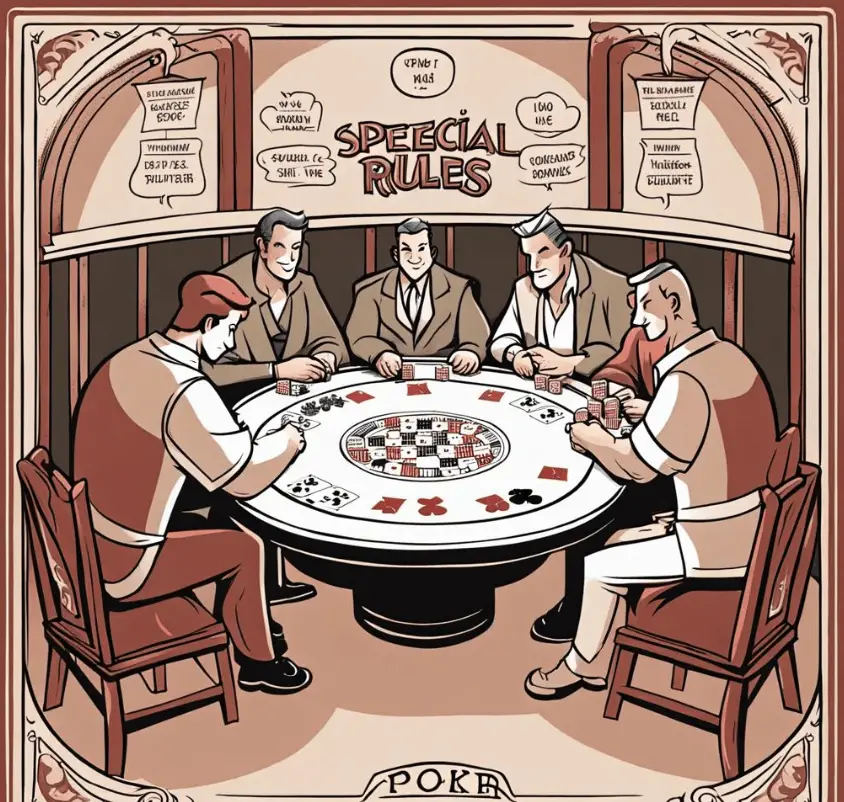
Let’s take a look at some of the special betting rules in poker that can catch even the most experienced players off guard.
All-in bets
Going all-in means you’re putting all your chips on the line. You’re either gonna win big or go home empty-handed. When you’re all-in, you can only win the pot that was there when you went all-in. Any extra bets go into a side pot that you can’t touch.
Side pots
Side pots are like the VIP section of the poker club. They’re created when one or more players are all-in and the other players keep betting. The all-in player can only win the main pot, while the players with chips left battle it out for the side pot.
Minimum and maximum raise amounts
In No-Limit Hold’em, the minimum bet is usually the size of the big blind. The minimum raise is equal to the size of the previous bet.
So if someone bets $10, you gotta put in at least $20 to raise. The sky’s the limit for a maximum bet – you can go all-in whenever you want!
In Pot-Limit Hold’em, the maximum bet is the size of the pot. To calculate it, add up the pot, the bet, and your call. So if the pot’s $15 and someone bets $10, you can bet up to $45 total ($15 pot + $10 bet + $10 call + $35 pot-sized raise).
In Fixed-Limit Hold’em, you bet and raise in fixed increments. Before the flop and on the flop, it’s the size of the small bet. On the turn and river, it’s the size of the big bet. And there’s usually a cap on the number of raises allowed.
String bets and raises
String bets are a big no-no in poker. That’s when you try to make multiple bets or raises in one motion, like saying “I call your $100 and raise you $500.” Nope, not allowed! You gotta declare your action in one fell swoop.
Remember, verbal declarations are binding. If you say “raise” but only put in enough chips for a call, you gotta add more chips to match what you said.
So there you have it, folks – the ins and outs of some tricky betting rules. Keep ’em in mind next time you’re at the table, and you’ll be playing like a pro in no time!
Betting Etiquette and Procedures in Poker

It’s time to talk about some important poker etiquette and procedures that will keep the game smooth and prevent any ruffling of feathers.
Acting in turn
First up, acting in turn. This is a biggie. Wait your turn, people! Don’t jump the gun and act before it’s your turn, even if you know you’re gonna fold.
Why? Because it gives an unfair advantage to the players who haven’t acted yet. They get extra info they shouldn’t have. So, keep your cards and your actions to yourself until the action’s on you.
Verbal declarations
Next, let’s talk about verbal declarations. In poker, your word is your bond. If you say “call,” that’s it – you’ve called, even if you meant to say “raise.” The same goes for betting.
If you verbally declare a bet or raise, that’s the amount you have to put in the pot. So, think before you speak, and speak clearly.
Proper chip handling
Now, about those chips. Splashing the pot might look cool in the movies, but at the poker table, it’s a big no-no. Don’t just toss your chips into the middle willy-nilly.
It makes it hard for everyone to see how much you’re betting. Instead, stack your bet neatly in front of you, separate from your other chips.
Another thing – string bets. That’s when you put some chips in, then go back for more. Nope, not allowed. Make your bets in one clean motion. Announce “raise” and then put in the total amount you want to bet.
Protecting your hand
Last but not least, protect your hand. Use a chip or card protector to keep your cards safe. You don’t want them getting mixed up with the muck or accidentally folded. And keep ’em in your sights at all times.
So there you have it, folks. Acting, in turn, makes clear verbal declarations, handles your chips properly, and protects your hand. Master these etiquette essentials, and you’ll be the model of a classy, respectful poker player.
Remember, it’s not just about playing your cards right – it’s about treating your fellow players right, too. Happy betting!
Advanced Betting Concepts in Poker
Now that we have covered the fundamentals of poker betting, let’s look into some advanced concepts that will help you to improve your game.
1. Value betting
Value betting is when you bet with a strong hand, hoping your opponent will call with a weaker one. It’s like fishing with a juicy worm – you want the fish to bite!
For example, if you’ve got a flush on the river, you might bet big to get your opponent to call with a straight or two pair. That’s how you reel in the big bucks!
2. Bluffing and semi-bluffing
Bluffing is the opposite of value betting. It’s when you bet with a weak hand, hoping to scare your opponent into folding a better one. It’s like playing a game of chicken – you’re betting your opponent will blink first! Semi-bluffing is a mix of the two.
You bet with a hand that’s not quite there yet but has the potential to improve. It’s like betting on a horse that’s coming up from behind – it might not be in the lead now, but it could be by the finish line!
3. Pot odds and implied odds
Pot odds are the price you’re getting to call a bet, based on the size of the pot. It’s like figuring out if a bet is worth taking based on the payout.
For example, if there’s $100 in the pot and your opponent bets $10, you’re getting 10:1 pot odds. If your odds of winning are better than that, it’s a good call!
Implied odds take it a step further by considering how much you could win on future streets if you hit your hand. It’s like betting on the potential for a bigger payout down the road.
For instance, if you’ve got a flush draw and think your opponent will pay off big if you hit it, your implied odds are juicy!
4. Position and its impact on betting
Position is key in poker, and it makes a big difference in how you bet. Being in position (acting last) is like having the home-court advantage.
You get to see what your opponent does before making your move. Out-of-position is trickier, like playing an away game. You have to act first, which can be tough.
For example, if you’re in a position with a top pair on the flop, you might check to see what your opponent does.
If they bet, you can raise for value. If they check, you can take a free card or bet for protection. But if you’re out of position with that same hand, you might bet right away to avoid giving a free card.
Common Betting Mistakes to Avoid
Now, let’s talk about some common betting blunders that can really put a dent in your poker profits. Avoid these mistakes like the plague, and you’ll be well on your way to crushing the tables!
1. Overvaluing hands
One of the biggest no-nos in poker is overvaluing your hands. Just because you’ve got a pair of pretty ladies (like pocket queens) doesn’t mean they’re unbeatable.
The board could bring all sorts of scary cards that make your hand look like a limp noodle. And don’t even get me started on Big Slick (Ace-King)! Sure, it looks sexy, but if you don’t hit the flop, you’re left with nothing but a high card and a whole lotta regret.
2. Failing to consider position
Position is king in poker, and if you’re not paying attention to it, you’re gonna have a bad time. Playing a hand from an early position is like being the first one to jump into a dark pool – you have no idea what’s lurking beneath the surface.
But when you’re in late position, it’s like having a crystal ball. You get to see what everyone else does before making your move. So, adjust your hand selection based on your position, and you’ll be playing smarter, not harder.
3. Inconsistent bet sizing
Bet sizing is an art form, and if you’re all over the place with your bets, you’re gonna be easier to read than a Dr. Seuss book.
If you’re betting big with your strong hands and small with your weak ones, you might as well hold up a neon sign that says “I’ve got the nuts!” or “I’m bluffing!” Mix it up and keep your opponents guessing, and you’ll be raking in the chips in no time.
4. Ignoring opponents’ tendencies
Poker is a game of people, not just cards. If you’re not paying attention to your opponents’ tendencies, you’re missing out on a goldmine of information. Is the guy across the table a calling station who never met a hand he didn’t like?
Bet your strong hands for value and watch the chips come rolling in. Is the lady to your left a tight-aggressive player who only plays premium hands? Proceed with caution and be ready to fold when she comes out firing.
Conclusion
All right, let’s end on a high note. Understanding betting rules in poker is like learning to drive – it’s essential if you wanna get anywhere in the game.
You gotta know when to hit the gas (raise), when to cruise (call), and when to hit the brakes (fold). But here’s the kicker: the road to poker success is always under construction.
You gotta keep learning and adapting your betting strategy. The poker landscape changes faster than a chameleon on a disco floor. So, stay sharp, keep studying, and never stop fine-tuning your game.
Remember, in poker, the minute you think you’ve got it all figured out is the minute you start losing. Keep your eyes on the prize and your mind on the grind!




